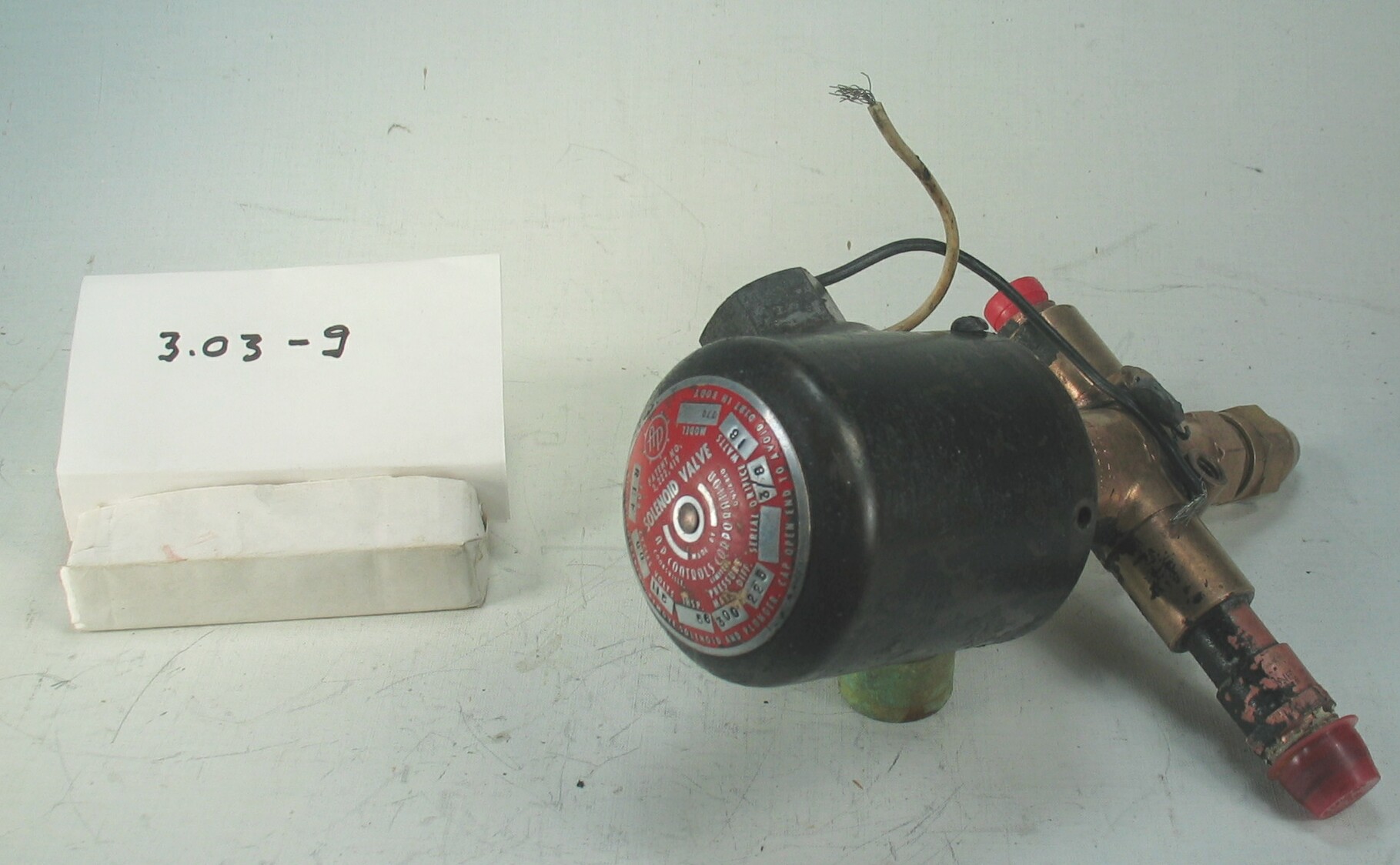3.03-7: Detroit Controls 1953 Electro-Magnetic Flow Control Valve

| HHCC Accession No. 2006.074 | HHCC Classification Code: 3.03-7 |
|---|
Description:
A 1950’s, electro-magnetic solenoid, refrigerant flow control valve for low pressure refrigerant applications, designed for Freon 12 and 22, in addition to sulphur dioxide and methyl chloride, with brass body and press formed, ferro-magnetic cover fitted with ‘ inch electrical connector, and handsome nameplate in green and silver, alternating current, 60 cycle, with single voltage 220volts coil and 14 inch stranded wire plastic insulated leads, Detroit Controls, Circa 1953
Group:
3.03 Refrigerant Flow Controls - NEC
Make:
Detroit Controls
Manufacturer:
Detroit Controls, Division of American Standard
Model:
683
Serial No.:
5825
Size:
4 x 3 x 5’h
Weight:
6 lbs
Circa:
1953
Rating:
Exhibit, education, and research quality, illustrating the engineering and application of electro-magnetic solenoid switching, refrigerant flow controls in operation in the early post W.W.II years
Patent Date/Number:
Provenance:
From York County (York Region) Ontario, once a rich agricultural hinterlands, attracting early settlement in the last years of the 18th century. Located on the north slopes of the Oak Ridges Moraine, within 20 miles of Toronto, the County would also attract early ex-urban development, to be come a wealthy market place for the emerging household and consumer technologies of the early and mid 20th century.
This artifact was discovered in the 1950’s in the used stock of T. H. Oliver, Refrigeration and Electric Sales and Service, Aurora, Ontario, an early worker in the field of agricultural, industrial and consumer technology.
Type and Design:
- 60 cycle electro-magnetic
Construction:
- brass body
Material:
Special Features:
Stylish company logo in green and silver The art-deco styling of the 1930’s had disappeared to be replaced by the simple functional styling characteristic of the 1950’s The use of inorganic electrical insulation materials is indicated by the plastic covered leads [compare items ID 196 and 197] The streamlined, heavy brass-mounting boss, tapped for two 10-32-machine screws for support of the valve. Inlet strainer
Accessories:
Capacities:
Performance Characteristics:
Operation:
Control and Regulation:
Targeted Market Segment:
Consumer Acceptance:
Merchandising:
Market Price:
Technological Significance:
With a simpler more functional and smoother look, this device is, in many ways, representative of the advancements in engineering and styling changes in refrigeration component technology between the 1930’s and 50’s.
More sophisticated manufacturing processes, backed by more engineering design know-how and the availability of new synthetic dielectric insulating materials and finishes all lead to a world change in look and in the reliability of performance. For historic context see ID # 196-197
The increased use of the Freon series of refrigerants, F12 and F22 encouraged the development of valves with larger and larger capacities, up to 50 tons by Detroit Controls. See reference cat. Bulletin #199
Industrial Significance:
Refrigerant flow control quickly became a matter of interest for refrigeration system design engineers in the 1930’s with the development of low-pressure refrigerants and a growing market for small versatile, mechanical refrigeration systems - able to operate multiple evaporators, often at different suction temperatures. The suction pressure regulating valve was one solution [See ID # 192, 193, 194]. The solenoid valve with electric pressure or temperature actuated controller was another option awaiting development.
From the 1930’s thorough 1950’s the industry produced electric solenoid valves in a wide variety of configurations and sizes, to perform a wide range of system functions, each with different performance requirements and characteristics, each manufacturer bringing to the market place his unique approach to engineering design and construction. Some of these are illustrated in the collection ID # 196 to 200:
ID # 196 ‘ Penn, brass body, 3/8 IPS, 7/32 orifice, 60 cycle, dual voltage 115/230 volts AC, 14 watts, adapted for two point mounting bracket, circa 1939
ID # 197 ‘ Penn, brass body, 3/8 IPS, 7/32 orifice, 25 cycle single voltage 115 volts AC, 14 watts, adapted for two point mounting bracket, circa 1939
ID # 198 ‘ Detroit Controls, brass body, 3/8 flare, 3/16 orifice, 60 cycle single voltage 130 volts AC, 15 watts, Circa 1953
ID # 199 ‘ General Controls, steel body, 3/8 IPS inlet, 3/8 outlet with brass half union connection, 177 port, 60 cycle single voltage 230 volts AC, 14 watts, Circa 1960
ID # 200 - Automatic Products [AP], brass body, with manual lift, ‘ inch sweat, inlet and outlet, 3/8 orifice, 60 cycle single voltage 120 volts AC, adapted for single point mounting bracket, 16 watt, Circa 1955
Socio-economic Significance:
For cost considerations, in the era of ‘open’ refrigeration systems, in the late 1920’s through to the pre World War II years, a popular practice was to operate two or more evaporators, even those at different temperatures, on a single condensing unit, a design known as multiplexing. The design of multiplexed, commercial refrigeration systems was a significant part of the evolution of the early 19th century Canadian commercial refrigeration industry. The electric solenoid valve played a major part in this evolution, changing Canadian’s expectations of the range of fresh foods and confectioneries available from there local friendly down town merchant.
Socio-cultural Significance:
Donor:
G. Leslie Oliver, The T. H. Oliver HVACR Collection
HHCC Storage Location:
Tracking:
Bibliographic References:
Air Conditioning Controls, Expansion Valves and Solenoid Valves, Cat 200E, 1957 Solenoid Valves, Capacities to 50 Tons Freon-12, Cat 199, 1953 Handbook of Engineering Fundamentals, Section 8-24,Ovid W. Eshbach, John Wiley and Sons, 1936







